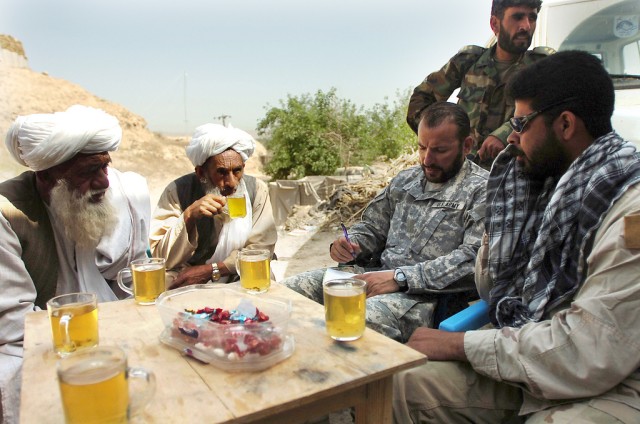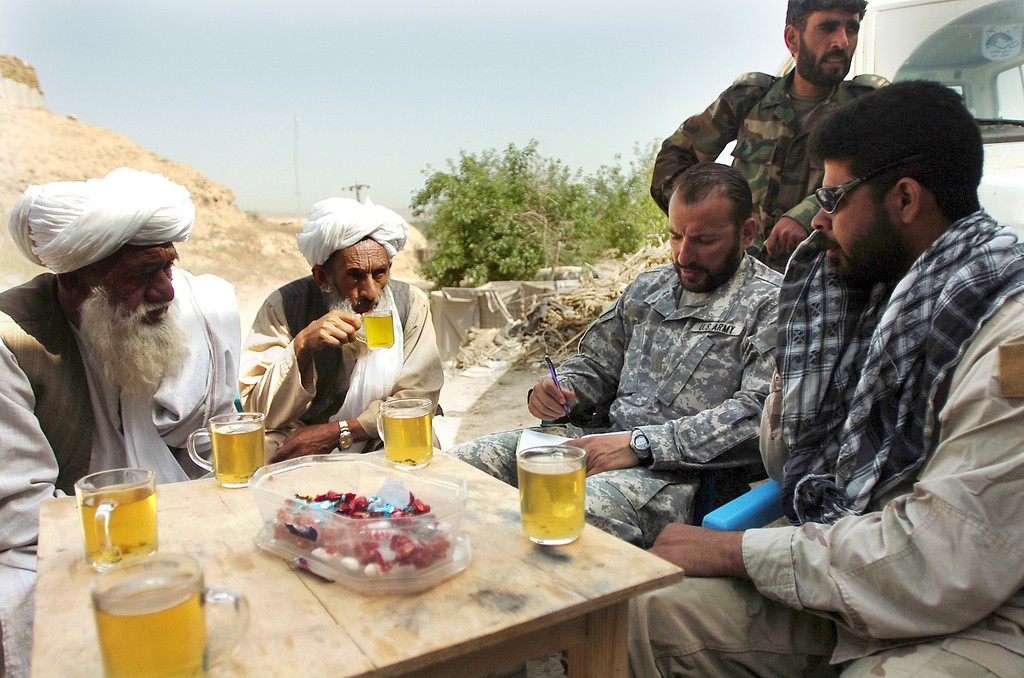So long as the present ideological conflict between East and West continues, so long as the mutual balance of terror makes a hot war improbable, and so long as the stresses and strains of nationalism and radicalism add fuel to the fire, the Western allies are likely to find themselves involved willy-nilly in a prolonged series of cold war operations, in many of which, by their very nature, the guerrilla and counterguerrilla will inevitably have their part to play. It is therefore important to keep under constant review the laws and principles which govern the conduct of irregular warfare. - Sir Fitzroy Maclean as part of the foreword to Charles Thayer's Guerrilla1
In the 1960s and again in the 1980s, the U.S. military experienced a revival of interest in irregular warfare, or IW, similar to the one that is occurring today. In both of the previous periods, the topic enjoyed a celebrity-like popularity in professional military forums until such time that circumstances allowed it to be relegated back to the margins in favor of a return to "proper soldiering."
Both previous revivals produced high-quality doctrine and curriculum in professional-education courses. So why, then, did IW fail to become ingrained as part of the military mainstream' The manner in which a topic is framed can significantly influence the opinion of the target audience. Suggesting that IW is the graduate level of warfare, while clearly expressing the topic's difficulty, fails to recognize the considerable effort that the Army has invested in mastering major combat operations, or MCO. Given the imbalance between the Army's investment in MCO and in IW, it's not surprising that, by comparison, IW appears more difficult and complex. Over the last several decades, old IW concepts have often been reintroduced or reinvented under new names, such as "low-intensity conflict" and "military operations other than war." While there is no question that those concepts are complex, presenting them as new byproducts of emerging and changing world conditions, such as globalization, urbanization and radicalization, brings into question not only the enduring nature of the IW requirement but also whether these conflicts are, in fact, merely anomalies to be weathered. While labels and marketing techniques may be helpful in reconciling our collective discomfort with the topic, they undermine the overall integration of the topic by further entrenching skeptics.
As was the case in the past, today's debate has the potential to divide the military into two camps: advocates and skeptics. Regrettably, the discussion often moves away from the specifics of IW to devolve into a debate over whether conventional or irregular warfare is superior or more difficult and how limited resources should be allotted. The argument for either discipline to take precedence over the other will likely remain a self-defeating one in the long term. The reality seems clear that whether or not the U.S. military accepts IW as an enduring part of the realm of conflict, it has been a normal condition throughout the last century, and all indications are that it will remain so through the first half of this century - alongside major, large-scale combat operations. While the topic of IW is clearly not new, the concept of how it will be defined, what it will encompass and how it will be integrated into the current portfolio of the U.S. military is. The terminology chosen to define this topic will be critical, not only in terms of its clarity but also for the perception that must accompany it. Unfortunately, the topic comes already enmeshed in the significantly confusing terminology created during previous periods of interest.
The joint operating concept, or JOC, outlines the process of incorporating IW within the military. JOCs are different from doctrine, which is based on time-proven practices.
JOCs are intended to link strategic guidance to the development of future capabilities. JOCs can ultimately lead to changes in policy, doctrine, organization, training, material, leadership, education, personnel and facilities.
IW is currently defined in DoD Directive 3000.07 as "a violent struggle among state and nonstate actors for legitimacy and influence over the relevant population(s).
IW favors indirect and asymmetric approaches, though it may employ the full range of military and other capacities in order to erode an adversary's power, influence and will."3
The current definition for IW was deliberately written to emphasize its focus on the population. DoDD 3000.07 also identifies five subordinate categories that compose IW: counterinsurgency, or COIN; counterterrorism, or CT; foreign internal defense, or FID; stability operations, or SO; and unconventional warfare, or UW.4
Since 1954, the Army has maintained a continuous base of significant expertise in IW within the U.S. Army Special Warfare Center at Fort Bragg, N.C., (renamed the John F. Kennedy Special Warfare Center and School, or SWCS, in 1963, following the death of President John F. Kennedy). The Special Warfare Center originally taught three training courses: the UW Course, the COIN Course and the Psychological Warfare Course. Since that time, the SWCS course load has expanded to encompass a much larger variety in courses of instruction, with an increasing throughput of students. SWCS also maintains more than 80 doctrinal and training publications and has technical review authority for three joint publications.
Unconventional warfare
UW is defined as activities conducted to enable a resistance movement or insurgency to coerce, disrupt or overthrow a government or occupying power by operating through or with an underground, auxiliary or guerrilla force in a denied area.
The concept of UW was developed largely from the experiences of World War II Soldiers who worked with resistance movements. The term UW was formally introduced into doctrine in 1955, specifically to convey a wider responsibility than simply working alongside guerrilla forces and conducting guerrilla warfare. Early leaders within the Special Forces, or SF, community recognized the criticality of achieving a holistic strategy that would not exclude the less familiar but equally important aspects of resistance, such as subversion, developing supporting clandestine infrastructure, sabotage and intelligence-related activities.
SF (and SWCS) have been and remain the Army's proponent for UW training, doctrine and execution. The UW Course was designed to prepare NCOs and officers to infiltrate enemy territory, link up with resistance forces and provide the full spectrum of training, support and advice needed to enable those forces and synchronize their efforts with those of the U.S. The course continues to this day, although it is now formally referred to as the Special Forces Qualification Course, or SFQC, or as the "Q Course."
Counterinsurgency
COIN is defined as those military, paramilitary, political, economic, psychological and civic actions taken by a government to defeat an insurgency.
A logical counterpart to the UW instruction was the development of the Counterinsurgency Course. SWCS began incorporating doctrine on COIN operations into FM 31-21, Special Forces Operations, in 1965. The schoolhouse also established the U.S. Army Special Warfare Center Department of Counterinsurgency that collaborated on other Army doctrine such as FM 31-15, Operations Against Irregular Forces; FM 31-16, Counterguerrilla Operations; and special texts such as ST 31-76, the COIN Planning Guide.
Foreign internal defense
FID is defined as participation by civilian and military agencies of a government in any of the action programs taken by another government to free and protect its society from subversion, lawlessness and insurgency.
As troop levels in Vietnam began to draw down in 1970, interest in COIN doctrine began to wane. The result was that the doctrine of the 1970s retained the COIN lessons learned in Vietnam and reflected the topic as military assistance to allied partner nations. In 1977, a chapter on FID replaced the chapter on COIN in FM 31-20, Special Forces Operations. Since the development of the FID concept, SWCS has remained the proponent for its doctrine. The Military Assistance Training Advisor Course, which stood up at the Special Warfare Center in 1962, trained joint military personnel in the skills required to serve as advisers, predominantly in South Vietnam. The training included language instruction that was similar to that of the UW Course. Although the MATA course closed in 1970, many of its lessons were retained and incorporated into the Special Forces, Psychological Operations and Civil Affairs courses. The topic of FID proved to be so valuable that in 1994, SWCS produced the first FID field manual. That eventually led to the development of JP 3.07.1, Joint Tactics, Techniques and Procedures for Foreign Internal Defense, which was written for the joint military community by the U.S. Special Operations Command.
Stability operations
SO is an overarching term encompassing various military missions, tasks and activities conducted outside the United States in coordination with other instruments of national power to maintain or re-establish a safe and secure environment and to provide essential governmental services, emergency infrastructure reconstruction and humanitarian relief.
Stability operations, like FID, saw doctrine developments as interest in COIN lessened following Vietnam. Much COIN doctrine was incorporated into the stability-operations chapter of FM 31-20, as well as into the Psychological Operations, SF and Civil Affairs courses. In 1967, the handbook from the MATA course was used to develop Field Manual 31-73, Handbook for Advisors in Stability Operations.
Counterterrorism
DoDD 3000.07 defines CT as operations that include the offensive measures taken to prevent, deter, pre-empt and respond to terrorism. Although there is little doctrine or curriculum related to the topic of CT, FM 3.05.20 (formerly FM 31-20), Special Forces Operations, has included material on CT since 1977, and SWCS continues to conduct several courses related to countering terrorism. The subordinate categories of CT are: hostage rescue, recovery of sensitive material from terrorist organizations and attacks against terrorist infrastructure. As indicated in Title 10, U.S. Code, CT, along with UW and FID, has been a core activity for special-operations forces since 1987.
As it did during the mid-1960s and -1980s, the Army has done an exceptional job of relearning, re-establishing and re-institutionalizing its capability in the IW realm, but at a significant cost. In order for this period of interest to succeed where previous ones have failed, the focus must remain on institutionalizing the subject as a valid peer to other military subjects. IW must become a mainstream topic of the profession of arms rather than merely a fringe specialty relegated to a select few. Conversely, it must not be regarded (by the few) as an elite discipline, with the attendant pejorative view toward other military disciplines. History has shown that insurgency and terrorism will remain a normal part of the spectrum of conflict, often requiring the application of military power in order to preserve or protect U.S. national interests. The new challenge for this millennium is not the threat posed by IW or even how the Army will meet the challenge but rather how the Army will prepare itself for long-term success.


Social Sharing